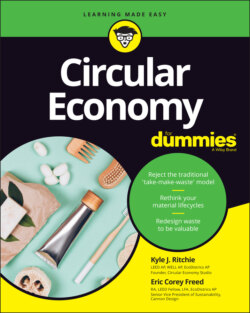Читать книгу Circular Economy For Dummies - Eric Corey Freed - Страница 94
All materials have another use
ОглавлениеThe take-make-waste philosophy suggests that once a material or product is used, it no longer serves a purpose. That is so unbelievably far from the truth, and it’s one of the main misunderstandings that has caused the global economy to produce so much waste and pollution to begin with. The recycling and reuse (or repurposing) of materials, which is one key principle of the circular economy framework, is a prevalent standard of the natural world.
Within the circular economy framework, materials are kept in flow by the continued repurposing or reuse of materials. In addition, these materials have the potential to transfer between organic and inorganic states via a particular biogeochemical cycle.
The biogeochemical cycle may sound complex, but it is essentially the range of vehicles used to circulate the nutrients of our planet! Organic matter can then be transferred between their various human uses and these natural storage compartments. But, for this management of materials to work properly, the way our global products are engineered and designed must be built to facilitate this material recycling to eliminate waste and provide a quality service to mankind.
Two standard practices of engineering can help design the world: traditional (or human) engineering and ecological engineering. Traditional engineering often results in the production and collection of various waste materials that not only offer no value to other systems but also hold the potential to damage the value of adjacent systems. The design’s priority is to provide humans with a service, and it doesn’t acknowledge the externalized costs associated with its implementation. Ecological engineering — or the design of sustainable ecosystems that integrate human society with its natural environment for the benefit of both — does just the opposite. Ecological engineering aims to minimize the externalized costs associated with the design and to discover creative ways to redirect its waste as an input for another system. An example of this concept may be the utilization of riparian acreage — the vegetation barrier between land and a body of water, in other words — to filter inorganic fertilizers out of stormwater runoff before it enters rivers and streams.
By reviewing the Ellen MacArthur Foundation’s butterfly diagram — see Chapter 10 for a deeper dive — you’ll see that organic and inorganic materials must flow through their individual systems differently. The process of harnessing and maximizing the value of inorganic materials requires different processes than organic materials. Within both systems, however, waste can become a non-issue as the output of one system can feed into another system.
